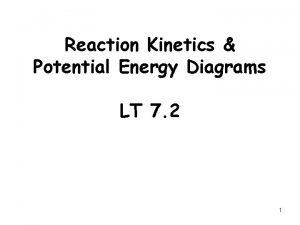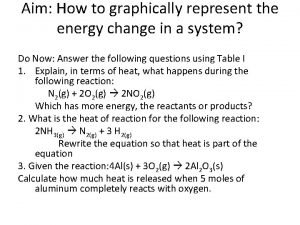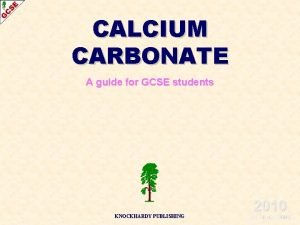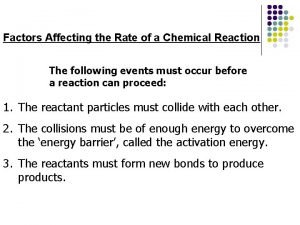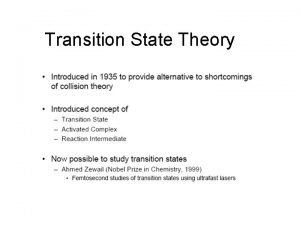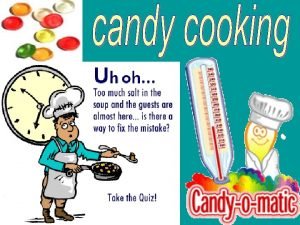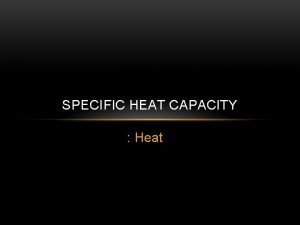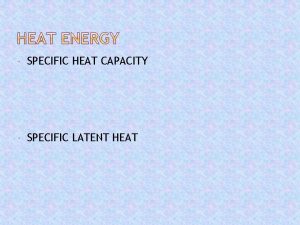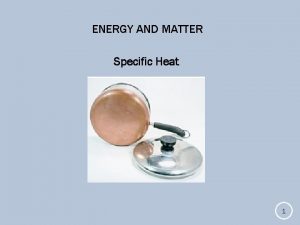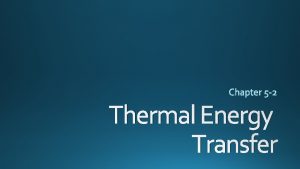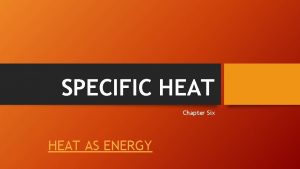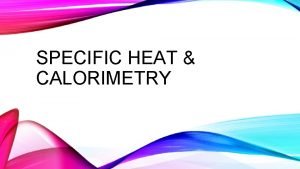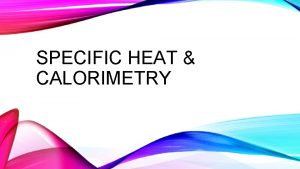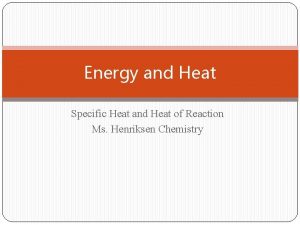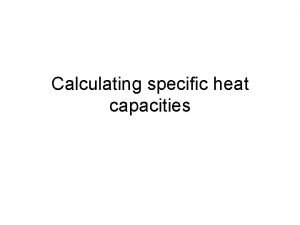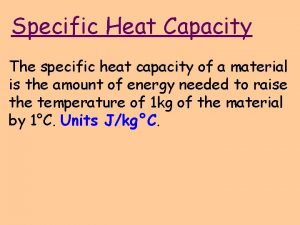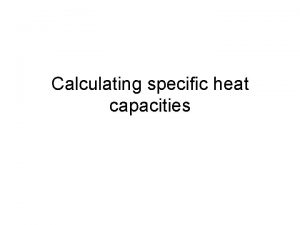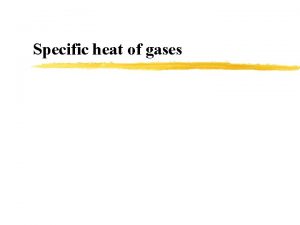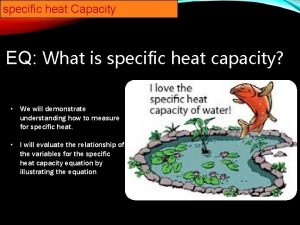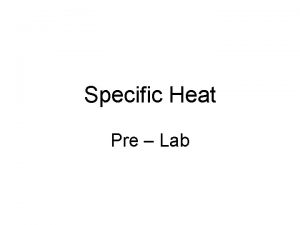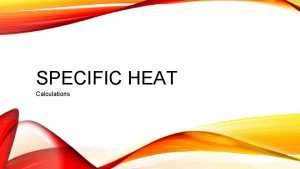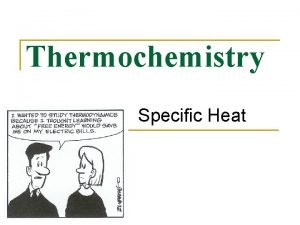Reaction Energy Specific Heat u The specific heat






























































- Slides: 62

Reaction Energy

Specific Heat u The specific heat of any substance is the amount of heat required to raise the temperature of one gram of that substance by one degree Celsius. u Because different substances have different compositions, each substance has its own specific heat.

Exothermic and Endothermic Exothermic: Heat flows out of the system (to the surroundings). The value of ‘q’ is negative. Endothermic: Heat flows into the system (from the surroundings). The value of ‘q’ is positive.

Specific Heat q = m Cp ΔT q = heat (J) Cp = specific heat (J/(g. °C) m = mass (g) ΔT = change in temperature = Tf – Ti (°C)

Measuring Heat u Heat changes that occur during chemical and physical processes can be measured accurately and precisely using a calorimeter. u A calorimeter is an insulated device used for measuring the amount of heat absorbed or released during a chemical or physical process.

A coffee-cup calorimeter made of two Styrofoam cups.

Phase Changes Melting Solid Vaporization Liquid Freezing Gas Condensation

Sublimation Melting Solid Vaporization Liquid Freezing Gas Condensation Deposition


Latent Heat q = m Hv q = m Hf Hv = latent heat of vaporization (J/g) Hf = latent heat of fusion (J/g)

Energy and Phase Change u Heat of vaporization (Hv) is the energy required to change one gram of a substance from liquid to gas. u Heat of fusion (Hf) is the energy required to change one gram of a substance from solid to liquid.

Specific Heat Problem 1) The temperature of a sample of iron with a mass of 10. 0 g changed from 50. 4°C to 25. 0°C with the release of 114 J heat. What is the specific heat of iron? -114 q = 10. 0 m Ciron (25. 0 ∆T – 50. 4) Ciron = 0. 449 J/g°C

Specific Heat Problem 2) A piece of metal absorbs 256 J of heat when its temperature increases by 182°C. If the specific heat of the metal is 0. 301 J/g°C, determine the mass of the metal. m = 4. 67 g

Specific Heat Problem 3) If 335 g water at 65. 5°C loses 9750 J of heat, what is the final temperature of the water? Tf = 58. 5 °C

Specific Heat Problem 4) As 335 g of aluminum at 65. 5°C gains heat, its final temperature is 300. °C. Determine the energy gained by the aluminum. q = 70500 J

Latent Heat Problem 5) How much heat does it take to melt 12. 0 g of ice at 0 °C? q = 12. 0 m (334) Hf q = 4010 J

Latent Heat Problem 6) How much heat must be removed to condense 5. 00 g of steam at 100 °C? q = 5. 00 m (2260) Hv q = 11300 J

Latent Heat Problem 7) If 335 J of heat are added to melting 5. 00 g of gold, what is the latent heat of fusion for gold in J/g? Lf = 67 J/g

Latent Heat Problem 8) The latent heat of fusion for platinum is 119 J/g. Platinum absorbs 735 J of heat. What is the mass of platinum? m = 6. 18 g

HEATING AND COOLING CURVES

The heating curve has 5 distinct regions.

The horizontal lines are where phase changes occur. vaporization melting

During any phase change, temperature is constant. melting

Kinetic energy increases on any diagonal line, and potential energy increases on any horizontal line. melting

The melting point temperature is equal to the freezing point temperature. The boiling point is the same as the temperature where condensation takes place. melting

Use q = m Cp ΔT for all diagonal lines. Use q = m Hf for melting and q = m Hv for boiling. melting

A cooling curve also has 5 distinct regions. melting

For a cooling curve, kinetic energy decreases on any diagonal line, and potential energy decreases on any horizontal line. melting

Heating/Cooling Curve Problem melting 9. What is the freezing point of the substance? FP = 5°C

Heating/Cooling Curve Problem melting 10. What is the melting point of the substance? MP = 5°C

Heating/Cooling Curve Problem melting 11. What is the boiling point of the substance? BP = 15°C

Heating/Cooling Curve Problem melting 12. What letter represents the temperature where the solid is being heated? A

Heating/Cooling Curve Problem melting 13. What letter represents the temperature where the vapor is being heated? E

Heating/Cooling Curve Problem melting 14. What letter represents the temperature where the liquid is being heated? C

Heating/Cooling Curve Problem melting 15. What letter represents the melting of the solid? B

Heating/Cooling Curve Problem melting 16. What letters show a change in kinetic energy? A, C and E

Heating/Cooling Curve Problem melting 17. What letter represents condensation? D

18. What is the melting point of this substance? 19. At what time do the particles of this sample have the lowest average kinetic energy? Heating/Cooling Curve Problem melting 18. What is the freezing point of this substance? FP = 90°C

18. What is the melting point of this substance? 19. At what time do the particles of this sample have the lowest average kinetic energy? Heating/Cooling Curve Problem melting 19. At what time do the particles of this sample have the lowest average kinetic energy? 16 min

18. What is the melting point of this substance? 19. At what time do the particles of this sample have the lowest average kinetic energy? Heating/Cooling Curve Problem melting 20. How many minutes does it take the substance to condense? 4 min

Heating/Cooling Curve Problem melting 21. What is the temperature range for the substance to be a vapor? 150 <T < 205

Heating Curve for Water Section D: Section A: Water is C: Section B: Boiling. Ice is being heated Water is ice to the. The melting being heated is melting. point. to the boiling Section E: point. Steam is being heated.

Heating Curve for D Water Section E q = m. H v q = m Cp ΔT Section B Section C (gas) Section A qq==m. H m f. Cp ΔT(liquid) q = m Cp ΔT(solid)

Solving Problems u For Heat Ice Below 0 °C water: + Melt Ice At 0 °C + Heat Water Boil Water 100 °C At 100 °C + 0 °C - + Heat Steam Above 100 °C

Specific Heat and Latent Heat 22) How much heat does it take to heat 12 g of ice at – 6 °C to 25 °C water? Round to a whole number. You begin at ice below 0 °C. Note: The final temperature for this process cannot exceed 0 °C. q= 1 m 2(2. 05)(0 Cice ∆Tq = 148 J – 6)

Specific Heat and Latent Heat, cont. u How much heat does it take to heat 12 g of ice at – 6 °C to 25 °C water? Round to a whole number. Since the temperature needs to rise to 25 °C, you must melt the ice next. q = 12 m (334) Hf q = 4008 J

Specific Heat and Latent Heat, cont. u How much heat does it take to heat 12 g of ice at – 6 °C to 25 °C water? Round to a whole number. You now have water at 0 °C. The final temperature of the water should be 25 °C. q = 12 m (4. 18) Cwater (25 ∆T - 0) q = 1254 J

Specific Heat and Latent Heat, cont. u How much heat does it take to heat 12 g of ice at – 6 °C to 25 °C water? Round to a whole number. Finally, add all of the q values together. q = 148 + 4008 + 1254 q = 5410 J

Specific Heat and Latent Heat 23) How much heat does it take to heat 35 g of ice at 0 °C to steam at 150 °C? Round to a whole number. You begin with ice at 0 °C, so you should melt it first. q = 35(334) m Hf q = 11690 J

Specific Heat and Latent Heat, cont. u How much heat does it take to heat 35 g of ice at 0 °C to steam at 150 °C? Round to a whole number. You now have water at 0 °C. The final temperature of the steam is to be 150 °C. You must take the water to 100 °C before you can even convert it to steam. q = 35 m (4. 18)(100 Cwater ∆T - 0) q = 14630 J

Specific Heat and Latent Heat, cont. u How much heat does it take to heat 35 g of ice at 0 °C to steam at 150 °C? Round to a whole number. Now you have water at 100 °C. Convert this to steam. q = 35 m (2260) Hv q = 79100 J

Specific Heat and Latent Heat, cont. u How much heat does it take to heat 35 g of ice at 0 °C to steam at 150 °C? Round to a whole number. You must now take the steam at 100 °C to 150 °C. q = 35 m (2. 02)(150 Cice ∆T - 100) q = 3535 J

Specific Heat and Latent Heat, cont. u How much heat does it take to heat 35 g of ice at 0 °C to steam at 150 °C? Round to a whole number. Finally, add all of the Q values together. q = 11690 + 14630 + 79100 + 3535 q = 108955 J

Specific Heat and Latent Heat 24) How much heat does it take to convert 16. 0 g of ice to water at 0 °C? (5340 J)

Specific Heat and Latent Heat 25) How much heat does it take to heat 21. 0 g of water at 12. 0 °C to water at 75. 0 °C? (5530 J)

Specific Heat and Latent Heat 26) How much heat does it take to heat 14. 0 g of water at 12. 0 °C to steam at 122. 0 °C? (37400 J)

Calorimetry u For calorimetry problems, use the equation: – m Cp ΔT = m Cp ΔT which is based on the law of conservation of energy. Heat lost equals heat gained.

Calorimetry Problem 27) 125 g of water at 25. 6°C is placed in a foam-cup calorimeter. A 50. 0 g sample of the unknown metal is heated to a temperature of 115. 0°C and placed into the water. Both water and metal attain a final temperature of 29. 3°C. Determine the specific heat of the metal.

u 125 g of water at 25. 6°C is placed in a foam-cup calorimeter. A 50. 0 g sample of the unknown metal is heated to a temperature of 115. 0°C and placed into the water. Both water and metal have attain a final temperature of 29. 3°C. Determine the specific heat of the metal. Find the heat gained by the water. q = 125 m (4. 18) Cwater (29. 3 ∆T – 25. 6) q = 1930 J

u 125 g of water at 25. 6°C is placed in a foam-cup calorimeter. A 50. 0 g sample of the unknown metal is heated to a temperature of 115. 0°C and placed into the water. Both water and metal have attain a final temperature of 29. 3°C. Determine the specific heat of the metal. Since heat lost equals heat gained, determine the specific heat of the metal. -1930 q == 50. 0 m Cmetal (29. 3 ∆T – 115. 0) Cmetal = 0. 450 J/g°C

Calorimetry Problem 28) You put 352 g of water into a foamcup calorimeter and find that its initial temperature is 22. 0°C. What mass of 134°C lead can be placed in the water so that the equilibrium temperature is 26. 5°C? m = 477 g

Calorimetry Problem 29) You put water into a foam-cup calorimeter and find that its initial temperature is 25. 0°C. What is the mass of the water if 14. 0 grams of 125°C nickel can be placed in the water so that the equilibrium temperature is 27. 5°C? m = 58. 0 g
 Potential energy diagram
Potential energy diagram Potential energy diagram heat of reaction
Potential energy diagram heat of reaction Spcific heat of water
Spcific heat of water Latent heat release
Latent heat release Thermal energy vs heat energy
Thermal energy vs heat energy Energy energy transfer and general energy analysis
Energy energy transfer and general energy analysis Energy energy transfer and general energy analysis
Energy energy transfer and general energy analysis Rate of reaction
Rate of reaction Addition reaction and substitution reaction
Addition reaction and substitution reaction Leukoerythroblastic reaction vs leukemoid reaction
Leukoerythroblastic reaction vs leukemoid reaction Half time equation
Half time equation What is the specific gravity of gelato glycerin base
What is the specific gravity of gelato glycerin base Specific gravity and volume
Specific gravity and volume Hát kết hợp bộ gõ cơ thể
Hát kết hợp bộ gõ cơ thể Lp html
Lp html Bổ thể
Bổ thể Tỉ lệ cơ thể trẻ em
Tỉ lệ cơ thể trẻ em Gấu đi như thế nào
Gấu đi như thế nào Chụp tư thế worms-breton
Chụp tư thế worms-breton Bài hát chúa yêu trần thế alleluia
Bài hát chúa yêu trần thế alleluia Môn thể thao bắt đầu bằng chữ f
Môn thể thao bắt đầu bằng chữ f Thế nào là hệ số cao nhất
Thế nào là hệ số cao nhất Các châu lục và đại dương trên thế giới
Các châu lục và đại dương trên thế giới Công thức tiính động năng
Công thức tiính động năng Trời xanh đây là của chúng ta thể thơ
Trời xanh đây là của chúng ta thể thơ Mật thư tọa độ 5x5
Mật thư tọa độ 5x5 101012 bằng
101012 bằng độ dài liên kết
độ dài liên kết Các châu lục và đại dương trên thế giới
Các châu lục và đại dương trên thế giới Thơ thất ngôn tứ tuyệt đường luật
Thơ thất ngôn tứ tuyệt đường luật Quá trình desamine hóa có thể tạo ra
Quá trình desamine hóa có thể tạo ra Một số thể thơ truyền thống
Một số thể thơ truyền thống Cái miệng nó xinh thế
Cái miệng nó xinh thế Vẽ hình chiếu vuông góc của vật thể sau
Vẽ hình chiếu vuông góc của vật thể sau Nguyên nhân của sự mỏi cơ sinh 8
Nguyên nhân của sự mỏi cơ sinh 8 đặc điểm cơ thể của người tối cổ
đặc điểm cơ thể của người tối cổ V. c c
V. c c Vẽ hình chiếu đứng bằng cạnh của vật thể
Vẽ hình chiếu đứng bằng cạnh của vật thể Tia chieu sa te
Tia chieu sa te Thẻ vin
Thẻ vin đại từ thay thế
đại từ thay thế điện thế nghỉ
điện thế nghỉ Tư thế ngồi viết
Tư thế ngồi viết Diễn thế sinh thái là
Diễn thế sinh thái là Dot
Dot Số nguyên tố là số gì
Số nguyên tố là số gì Tư thế ngồi viết
Tư thế ngồi viết Lời thề hippocrates
Lời thề hippocrates Thiếu nhi thế giới liên hoan
Thiếu nhi thế giới liên hoan ưu thế lai là gì
ưu thế lai là gì Hổ sinh sản vào mùa nào
Hổ sinh sản vào mùa nào Sự nuôi và dạy con của hổ
Sự nuôi và dạy con của hổ Sơ đồ cơ thể người
Sơ đồ cơ thể người Từ ngữ thể hiện lòng nhân hậu
Từ ngữ thể hiện lòng nhân hậu Thế nào là mạng điện lắp đặt kiểu nổi
Thế nào là mạng điện lắp đặt kiểu nổi The overall reaction in a commercial heat pack
The overall reaction in a commercial heat pack Calcium carbonate heated strongly
Calcium carbonate heated strongly Factors affecting the rate of chemical reaction
Factors affecting the rate of chemical reaction Activation energy for reverse reaction
Activation energy for reverse reaction G = - rt ln k
G = - rt ln k Energy reaction coordinate diagram
Energy reaction coordinate diagram Specific heat unit
Specific heat unit Specific heat of syrup
Specific heat of syrup
